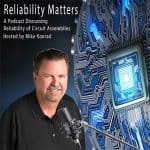
The Day in the Life of a Planner
What does a day in the life of a planner look like? Join us in our discussion as to what our ideas are for a planner.
[Read more…]
Your Reliability Engineering Professional Development Site
by George Williams Leave a Comment

What does a day in the life of a planner look like? Join us in our discussion as to what our ideas are for a planner.
[Read more…]
by Fred Schenkelberg Leave a Comment

The survival of an individual item is difficult to determine. Use and environmental conditions, along with material and assembly differences, count. Let’s explore how to model and use the naturally occurring variability to improve reliability performance. [Read more…]

Kirk and Fred discussing Kirk’s purchase of a new laptop and his expectations of reliability.
ᐅ Play Episode

In the last half of the 20th century, cleaning of circuit assemblies was a standard assembly practice. The abolishment of popular CFC-based cleaning solvents ushered the introduction of “no-clean” assembly processes. For much of the electronic assembly industry, cleaning became nonexistent.
Due to assembly and component miniaturization and the explosion of both IOT and automotive electronics, which places many circuit assemblies into harsh environments, the practice of removing harmful ionic contamination from circuit assemblies has once again become a mainstream practice. Today, the majority of electronic assemblies are cleaned. And, for many assemblers, cleaning is a new process.
This podcast will present modern best-practice cleaning techniques including:
– An historical look back at cleaning
– The reason for cleaning
– Reasons for cleaning no-clean flux residues
– Conventional cleaning technologies
– Estimating throughput capabilities on batch and inline cleaning systems
– Do’s and don’ts of cleaning circuit assemblies
– How to choose a cleaning chemical (if needed)
– How to determine the assemblies are clean during the cleaning process
– How to determine the assemblies are clean after the cleaning process
– New IPC Cleanliness assessment standards
– Environmental mitigation techniques
– Calculating the per-assembly cost of cleaning
– Keeping your cleaning machine in top-working order
by James Kovacevic Leave a Comment

There are a lot of aspects that need to be taken care of in condition monitoring and field balancing is one of those. There are two types of balancing; static and dynamic. The first one deals with balancing in a controlled environment and other one is purely balancing a piece of equipment in the field. When you have balanced an asset against a bunch if parameters, you know when there’s an unbalance in the equipment. There are different defects that can caught using a balancing frequency or other parameter. There are a lot of causes for unbalancing such as; corrosion, part damage, assembly error, and other machining tolerances.
In this episode, we covered:
by George Williams Leave a Comment
by Robert Kalwarowsky Leave a Comment

This week, I welcome on Tim Ingram. Tim is an asset management consultant and the chair of UK’s mirror committee for ISO 55000. In this episode, I speak to Tim about reliability blockchain, a concept of crowdsourcing reliability data from OEMs and equipment users. If you’re interested to learn more after the episode, check out reliabilityblockchain.com
My calendar has been filling up lately with conferences and I wanted to let you know where I’ll be podcasting and speaking. I will be in Chicago, Illinois at MaintenanceCon April 15-17th. Then I’ll be at Reliable Asset World in Clearwater Beach, Florida May 14-17 and I’ll be at Asset Management Manitoba Summit on June 7th in Winnipeg, Manitoba.
I’m looking for a new opportunity in maintenance & reliability so if you hear of any open positions that I might be suited for please let me know on LinkedIn or send me an email at robsreliabilityproject@gmail.com
If you enjoy the show, please tell your colleagues in reliability about it and follow Rob’s Reliability Project on LinkedIn. If you have any questions, business inquiries or if you’d like to appear on the podcast, email me at robsreliabilityproject@gmail.com
Follow Tim Ingram on LinkedIn – https://www.linkedin.com/in/tim-ingram-17554127/
Check out reliabilityblockchain.com
Follow Rob’s Reliability Project on LinkedIn – https://www.linkedin.com/company/robsreliabilityproject/
Follow Rob’s Reliability Project on Facebook – https://www.facebook.com/robsreliabilityproject/

Kirk and Fred discussing recent aircraft failures and how suppliers sort through all the reported data on failures and complaints from the field.
ᐅ Play Episode
by Adam Bahret Leave a Comment

Adam and Fred discussing the way customers use products is not inline with how they were designed.
ᐅ Play Episode
by James Kovacevic Leave a Comment

It is always a difficult first day for a reliability engineer in a new place. There are a lot of things to get yourself involved in and there are some tips that can really help you get through that successfully. The job of a reliability engineer requires always moving around, so there is hardly the need of finding the station first. A good reliability engineers always starts with getting the lay of the land first. This would involve getting to know the relevant personnel on the job and the people who can give you basic logistics of it.
In this episode, we covered:
by George Williams Leave a Comment

What is a backlog? What is the value? How do you calculate backlog? Join us as we seek to address these questions and a few other questions regarding backlog.
[Read more…]
by Mike Konrad Leave a Comment

X-ray has come a long way since its discovery in 1895. Originally used in the medical field, X-ray technology has been integrated into many industrial sectors including the electronic assembly industry. Dr. David Bernard is an expert in X-ray technology within the electronics industry. Dr. Bernard and I discuss the modern use of X-ray technology, applications within the electronic assembly industry and the skills required to interpret the images produced.
by Robert Kalwarowsky Leave a Comment

This week, I welcome on Fred Schenkelberg. If you haven’t heard of Fred, you haven’t been looking hard enough. Fred runs accendoreliability.com, does reliability consulting, teaches reliability at University of Maryland and hosts the Speaking of Reliability podcast. In this episode, I speak to Fred about the art of reliability. Fred answers what should reliability engineers do? What should we be learning and gives his take on what skills we need.
My calendar has been filling up lately with conferences and I wanted to let you know where I’ll be podcasting and speaking.
I will be in Chicago, Illinois at MaintenanceCon April 15-17th. I’ll be at Reliable Asset World in Clearwater Florida May 14-17 I’ll be at Asset Management Manitoba Summit on June 7th in Winnipeg, Manitoba.
I’m looking for a new opportunity in maintenance & reliability so if you hear of any open positions that I might be suited for please let me know on LinkedIn or send me an email at robsreliabilityproject@gmail.com
If you enjoy the show, please tell your colleagues in reliability about it and follow Rob’s Reliability Project on LinkedIn. I’m putting out, at a minimum, weekly videos for that page so if you follow my personal LinkedIn, you might miss out on some great stuff.
If you have any questions, business inquiries or if you’d like to appear on the podcast, email me at robsreliabilityproject@gmail.com
Follow Fred Schenkelberg on LinkedIn – https://www.linkedin.com/in/fmsreliability/
Check out accendoreliability.com
Follow Rob’s Reliability Project on LinkedIn – https://www.linkedin.com/company/robsreliabilityproject/
Follow Rob’s Reliability Project on Facebook – https://www.facebook.com/robsreliabilityproject/
by Tim Rodgers Leave a Comment

Tim Rodgers interviews Ryan about maintenance management system.
ᐅ Play Episode
by Adam Bahret Leave a Comment

Adam and Fred discussing a whirlwind trip Adam just completed including Miami, Orlando, Cleveland, Chicago, Fairbanks Alaska, and Costa Rica
ᐅ Play Episode
 Ask a question or send along a comment.
Please login to view and use the contact form.
Ask a question or send along a comment.
Please login to view and use the contact form.